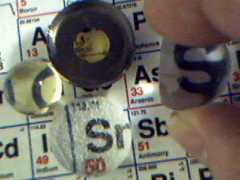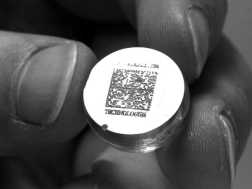







 |
 |
 |
 |
|||||
 |
 |
 |
||||||
 |
||||||||
WASHINGTON, Jan. 10
 Government
leaders from around the world convened at the White House to ask geologists
and technology experts for their help in the quest to end the trade of
conflict diamonds. These stones are dubbed conflict diamonds because
they are mined and sold to help insurgent groups in countries fraught with
civil unrest — particularly in the African nations of Sierra Leone, Angola
and the Democratic Republic of the Congo.
Government
leaders from around the world convened at the White House to ask geologists
and technology experts for their help in the quest to end the trade of
conflict diamonds. These stones are dubbed conflict diamonds because
they are mined and sold to help insurgent groups in countries fraught with
civil unrest — particularly in the African nations of Sierra Leone, Angola
and the Democratic Republic of the Congo.
“Trade in illegal diamonds not only fuels illegal economies, but it kills people,” said Gayle Smith, the U.S. National Security Council’s director of African affairs. “It threatens neighborhoods. They [insurgent groups] can buy arms with a convenient commodity they can stick in their pockets,” she said. “The situation threatens the stability and progress Africa has made over the last 20 years.”
The White House Conflict Diamond Conference marked the first time that policy-makers, diplomats, industry leaders and scientists have come together to tackle the illicit diamond trade. “These issues go well beyond emotion,” Smith said. “That’s where scientists play an important role.” International leaders asked geologists if their knowledge could put an end to illicit diamond trading through the geological identification of a diamond’s origin. The scientists’ response: No.
Geologic processes do not recognize political boundaries. Over geologic time, rivers form, surfaces erode and the precious gems are whisked away from their kimberlite or lamproite primary origin and eventually buried in secondary alluvial deposits along riverbeds and in river deltas. As a result, primary and secondary deposits of diamonds with identical compositions and crystal structures do not always occur within the same country. A diamond that formed millions of years ago in what is now South Africa can be mined today in Angola.
 Unlike
laundered drug money, a conflict diamond in polished form can almost never
be traced to its original source. Scientists may be able to identify a
gem’s primary geologic origin, but they can’t analyze every diamond that
enters the international diamond market.
Unlike
laundered drug money, a conflict diamond in polished form can almost never
be traced to its original source. Scientists may be able to identify a
gem’s primary geologic origin, but they can’t analyze every diamond that
enters the international diamond market.
[Right and below: One technology for tracking rough diamonds is encapsulating the stone in a clear polymer and laser-imprinting a data matrix on the polymer’s bottom that contains information about the gem’s origin. The technique, developed by 3Beams Technologies, overcomes the difficulty of branding a rough diamond. At top: The optical grade polymer used to encapsulate diamonds also acts as a magnifying glass. Images courtesy of Jayant Neogi, 3Beams Technologies.]

Compounding the challenge is the practice of mixing parcels of rough gems to make diamond packages more attractive to potential buyers. Namibian manufacturers commonly import rough diamonds to mix with their native diamonds before they are exported. As a result, any one stone can be bought and sold innumerable times before it ends up on the finger of a bride-to-be.
“Mixing parcels makes crystal morphology differentiation impossible,” said Mark van Bockstael, Director of International Affairs of the High Diamond Council in Antwerp, Belgium.
Some methods exist to tell the difference between rough diamonds that formed under different circumstances or were transported from their primary sources. Crystallographic or trace-element analyses can show that two diamonds formed in different places. On rough diamonds, surface imperfections such as lamination striping, corrosion, pitting and terracing can indicate an alluvial source. But when a stone is cut and polished, many of the clues that would distinguish an alluvial diamond from a primary diamond are erased.
“There are no practical means to determine the country of origin of a polished diamond,” said James Shigley, a geologist and the current director of research at the Gemological Institute of America who spoke at the White House conference (see Comment, this issue).
Mining alluvial diamonds is not difficult, and they are easy fodder for insurgent groups to mine and sell. All it takes to find a precious stone are two good eyes, a pick and a shovel. Access to alluvial deposits is geologically unrestricted and the diamonds can be stuffed into pockets, socks or whatever else is handy. A person can literally walk away from a mine and conceal hundreds of thousands of dollars.
Another geologist who spoke at the White House conference was Steven Haggarty of the University of Massachusetts. On a trip to Zimbabwe, he said, he once watched a man walk up to a barbed-wire fence and throw his boot over. Another man threw the boot back and the game repeated. Haggarty soon realized that the toe of the boot was stuffed with diamonds and that with every toss, more loot was sailing over the fence.
Because smuggling diamonds is easy, policy-makers such as Eli Izhakoff, chairman of the World Diamond Council and a speaker at the White House conference, feel that now is the time for steepening regulations on the import and export of diamonds. While others agree that policies must change, they also believe that placing a ban on all diamonds coming out of Africa would be grossly unfair.
A conflict diamond plucked from an Angola delta by a man mining at gunpoint can be disguised as a legitimate stone and purchased by a legitimate mining company in a country such as Botswana, where legal diamond trade is 70 percent of the country’s annual income. “By saying we’ll no longer buy diamonds from Africa, we’re ruining one of the five fastest growing economies in the world,” Smith said. “We need to create a regimen that is tight enough so that we can’t put diamonds in our pockets and get away with it.”
Technologies exist to tag individual diamonds, from laser-reflection patterning to encapsulation in biodegradable polymers. But the time and cost required to identify and tag each of the millions of diamonds produced every year in order to stop the 3 to 4 percent that are illegally traded is more than most are willing to consider. “The burden of inspecting each diamond individually would drive costs above a level that consumers can afford,” Fischer said. Tightening the security of parcels of diamonds as they travel from their native country might be more practical.
The World Diamond Council recently drafted model legislation to impose stricter regulations on the import and export of diamonds. Stones exported without proper certification would be barred from customs entry points. Tamper-proof containers and counterfeit-proof documentation would also be required. If the United Nations passes the legislation, regulations could be enacted as soon as August.
Laura Wright
 |
Geotimes Home | AGI Home | Information Services | Geoscience Education | Public Policy | Programs | Publications | Careers |